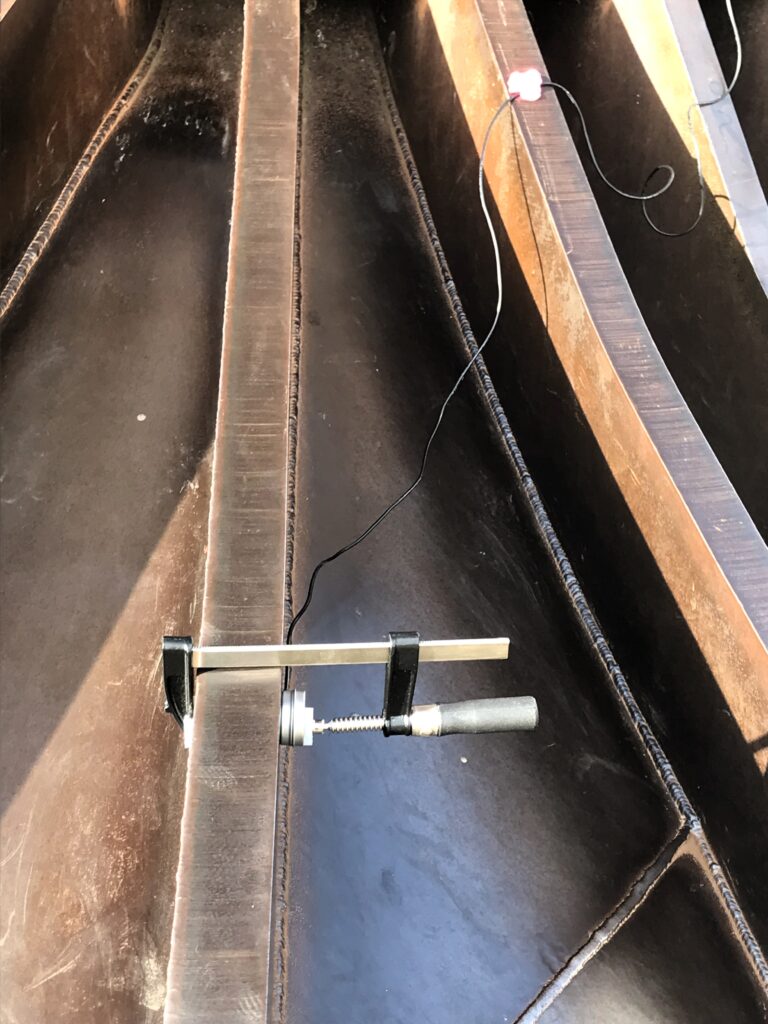
My second visit to The Angel with David took place on a very windy day. As I arrived, David emerged from the memorial in the trees, having made a short recording of the wind in the leaves. I entered the trees and took a few minutes to listen to the dry rustle as their branches waved above me, a sound that I strongly associate with this place. String had been threaded between two alder trees and packages filled with inscribed hearts were pegged to it, which spun and twisted in the air as the wind caught them.
Once we reached The Angel, David took out his new contact microphone, which he was able to clamp onto the ribs of the sculpture, rather than holding it in place as he did on our previous visit. This meant that there was less disturbance to the sound, as interference is caused by slight movements of the hand and the resulting changes in pressure of the microphone on the surface.
We tested the microphone on the west side of The Angel, having climbed the mound after leaving the shelter of the trees. The sound through the headphones was the same low pitch as on the previous recordings, but higher and clearer in tone. As gusts of wind buffeted the wings of The Angel, they resonated down into the sculpture and were clearly audible. David also set up a standing microphone to record the atmospheric conditions on site, so that these sounds could be in conversation with the recordings of the Angel’s interior vibrations.

David wanted to record at the same points on the Angel in different conditions, so we devised a rudimentary map of the sculpture. Walking round The Angel, I counted twenty ribs and we divided these into four groups of five. We mapped these onto the points of the compass, so that we were recording the west, north, east, and south faces of the sculpture.
Counting five ribs round, David clamped the microphone to the back of The Angel, as high as he could reach. The recording here was different in tone, having an eerie quality like the soundtrack of a horror film. The wind’s gusts were still audible, but less dominant than on The Angel’s western side.

Five more ribs counted, and we listened to the sound on The Angel’s east face, again placing the microphone as high on the sculpture as we could reach. As on the western side, the wind once more became the prominent feature. David recorded for five minutes in each location, and he explained that, once these files were placed in sequence, the distinctions between them would become more evident.
The final five ribs took us round to the south of the Angel and David fixed the microphone to the front of its feet. Here, the sound was softer and quieter, and the wind was muted. It felt as though The Angel was sheltering the sound, and us, from the force of the wind.

David had recorded at the site once more between our first and second visits, rising on a misty dawn to capture the site without the constant rumble of traffic. Even at this time on a Sunday morning, the flow of cars had been unceasing, however, and David had noted that his recordings of the Angel picked up the vibrations of passing vehicles. On this visit, we were unable to hear the resonances of the traffic, and it seemed that the vibrations to the structure caused by the buffeting of the wind were more audible, with the traffic noise receding to a supporting note.
As on our last visit to The Angel, there were several visitors to the site when we were recording. It was notable that this time they did not approach us to ask what we were doing. I wondered whether this was because of the shift in the recording equipment that we were using. On our first visit, David had held the microphone to the body of the Angel and looked like a doctor with a stethoscope. The new method of clamping the microphone to the sculpture involved less direct contact with The Angel, and David looked more like a structural engineer visiting the site to make tests. Even though we were involved in the same activity, it seemed that a minor change in the recording technique – namely, how David attached the contact microphone to The Angel – had changed the appearance of what we were doing, to make it look more technical and more scientific.
